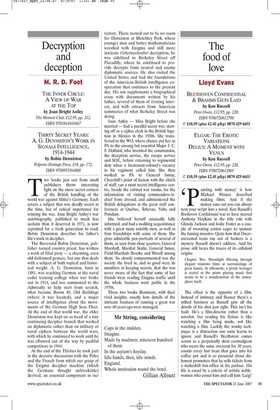Decryption and deception
M. R. D. Foot THE INNER CIRCLE: A VIEW OF WAR AT THE TOP by Joan Bright Astley The Memoir Club, £12.95, pp. 212, ISBN 9781841041667 THIRTY SECRET YEARS: A. G. DENNISTON'S WORK IN SIGNALS INTELLIGENCE, 1914-1944 by Robin Denniston Polperro Heritage Press, £18, pp. 172, ISBN 9780955364808 Two books just out from small publishers throw interesting light on the more secret corners of the British handling of the world war against Hitler's Germany. Each covers a subject that was deadly secret at the time, but of critical importance for winning the war. Joan Bright Astley's war autobiography, published to much less acclaim than it deserved in 1971, is now reprinted for a fresh generation to read; Robin Denniston describes his father's life's work in decipher.
The Reverend Robin Denniston, publisher turned country priest, has written a work of filial piety — a charming, even old-fashioned gesture, but one that deals with a subject of both topical and historical weight. A. G. Denniston, born in 1881, was teaching German at the naval cadet training college when war broke out in 1914, and was summoned to the Admiralty to help start from scratch, what became Room 40, Old Buildings (where it was located), and a major source of intelligence about the movements of the German High Seas Fleet. At the end of that world war, the elder Denniston was kept on as head of a tiny continuing decipher branch that worked on diplomatic rather than on military or naval ciphers between the world wars, with which he continued to work until he was elbowed out of the way by pushful competitors in 1944.
At the end of the Thirties he took part in the decisive discussions with the Poles and the French from which our grasp of the Enigma decipher machine (which the Germans thought unbreakable) derived, an essential component in our www.spectator.co.uk victory. There turned out to be no room for Denniston at Bletchley Park, where younger men and better mathematicians wrestled with Enigma and still more intricate Geheimschreiber decryption; he was sidelined to Berkeley Street off Piccadilly, where he continued to provide decrypts from neutral and enemy diplomatic sources. He also visited the United States and laid the foundations of the American-British intelligence cooperation that continues to the present day. His son supplements a biographical essay with documents written by his father, several of them of riveting interest, and with extracts from American summaries of what Berkeley Street was doing.
Joan Astley — Miss Bright before she married — had a parallel secret war, starting off as a cipher clerk in the British legation in Mexico in the 1930s. She transferred to the WO, where chance put her as PA to the unsung but essential Major J. C. E Holland, who invented the commandos, the deception service, the escape service and SOE, before returning to regimental duty when a lieutenant-colonel's vacancy in his regiment called him She then worked as PA to General Ismay, Churchill's point of liaison with the chiefs of staff; ran a most secret intelligence centre, beside the cabinet war rooms, for the information of visiting commanders-inchief from abroad; and administered the British delegations at the great staff conferences at Quebec, Teheran, Yalta and Potsdam.
She believed herself unusually fully informed, and had a nodding acquaintance with a great many notable men, as well as firm friendships with some of them. She gives admirable pen-portraits of several of them, as seen from close quarters, General Marshall, Marshal Stalin, General Ismay, Field-Marshals Brooke and Wavell among them. So closely compartmented was the society she lived in, and so good were its members at keeping secrets, that she was never aware of the fact that some of her friends were reading Enigma traffic until the whole business went public in the 1970s.
These two books illuminate, with their vivid insights, exactly how details of the intricate business of running a great war over 60 years ago were managed.





























































 Previous page
Previous page